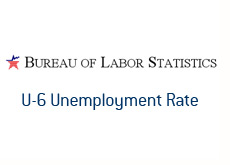Definition of U-6 Unemployment Rate
What is the definition of "U-6 Unemployment Rate"?
The Bureau of Labor Statistics releases a bunch of different unemployment numbers every month.
 The unemployment number that is most often used in the media (and by the government) is known as the "U-3". This number was 8.1% in February of 2009.
The unemployment number that is most often used in the media (and by the government) is known as the "U-3". This number was 8.1% in February of 2009. The "U-6" is considered to be a broader measure of the unemployment situation in the United States.
The "U-6" includes two groups of people that the "U-3" does not:
1. "Marginally attached workers" - people who are not actively looking for work, but who have indicated that they want a job and have looked for work (without success) sometime in the past 12 months. This class also includes "discouraged workers" who have completely given up on finding a job because they feel that they just won't find one.
2. People who are looking for full-time work but have to settle on a part-time job due to economic reasons. This means that they want full-time work, but can't find it.
Two pretty important groups of people, no?
The "official" unemployment number is the "U-3" - this was 8.1% in February.
The "U-6" was an eye-opening 14.8% in February.
--
Davemanuel.com Articles That Mention U-6 Unemployment Rate:
US Economy Added 98,000 Jobs in March, Unemployment Rate Fell to 4.5%
235,000 Jobs Added During Trump's First Full Month as President
White House Congratulates Itself Following January Jobs Report
280,000 Jobs Added in May; Unemployment Rate Ticks Up to 5.5%
January Employment Report: 257,000 New Jobs Added, Unemployment Rate Rises to 5.7%
